Amphibians are cold blooded vertebrates that live in both aquatic and terrestrial habitats through their life cycle. In their larval stage they live as aquatic organisms and then move onto land once they become adults, becoming terrestrial animals. Did you know the name amphibian actually comes from the Greek word amphibious, meaning living a double life?
Although adults are more terrestrial, they still need to keep near a water source in order to reproduce. Their eggs are most commonly laid in sheltered water bodies either singly or in strands or clusters covered in a jelly like substance. In general, once developed larvae must then survive on their own, finding their own food and avoiding predation. At this aquatic stage of their life larval amphibians have gills to breather underwater and tails for locomotion.
Once an amphibian reaches adulthood it undergoes a change called metamorphosis. This process allows the animal to absorb its gills back into its body and develop lungs, allowing it to breathe out of water. There are however exceptions, with some species never leaving the water and others never developing lungs but breathing through their skin instead. Most amphibians can also breathe through their skin, choosing to use their lungs when a higher respiration rate is needed. Breathing through the skin is a process called cutaneous respiration. Thin blood cells close to the surface allow gas to be exchanged between the blood and the air or water, giving the animal oxygen. For this process to take place amphibians must have damp and often slimy skin, which is created by secretions from mucous glands.
Amphibians can also use specialised secretions to defend themselves. Often covering themselves with secretions that taste bad to deter predators from eating them, they can also produce toxins as a further defence. Some species can even spray poisonous liquids at their attacker. Camouflage also acts as a defence strategy, allowing amphibians to blend in with their environment to avoid predation. This is why many species are dark brown or green to blend in with surrounding vegetation and soils.
As amphibians are cold blooded and they have very special skin, they require specific living conditions. They can never live too far away from a water source or damp environment in case their skin dries out and they get too dehydrated. A consequence of this is that amphibians cannot react well to change and often, if their habitats are destroyed or contaminated, they struggle to survive. Did you know over half of all frog species are in danger of extinction? The UK is only home to one native frog species, two toads and three species of newt.
Common Frog
Given their name, these frogs are common throughout the UK, distinguished by their greeny brown colour and long back legs decorated with black bands.
Living along waterways and in ponds, these frogs hunt at night time, preying on invertebrates and smaller amphibians, while consuming algae as tadpoles.
During breeding season they can be found laying their eggs in ponds or areas of still water. However, outside of this season these amphibians spend most of their time on land among plants in meadows and woodlands.
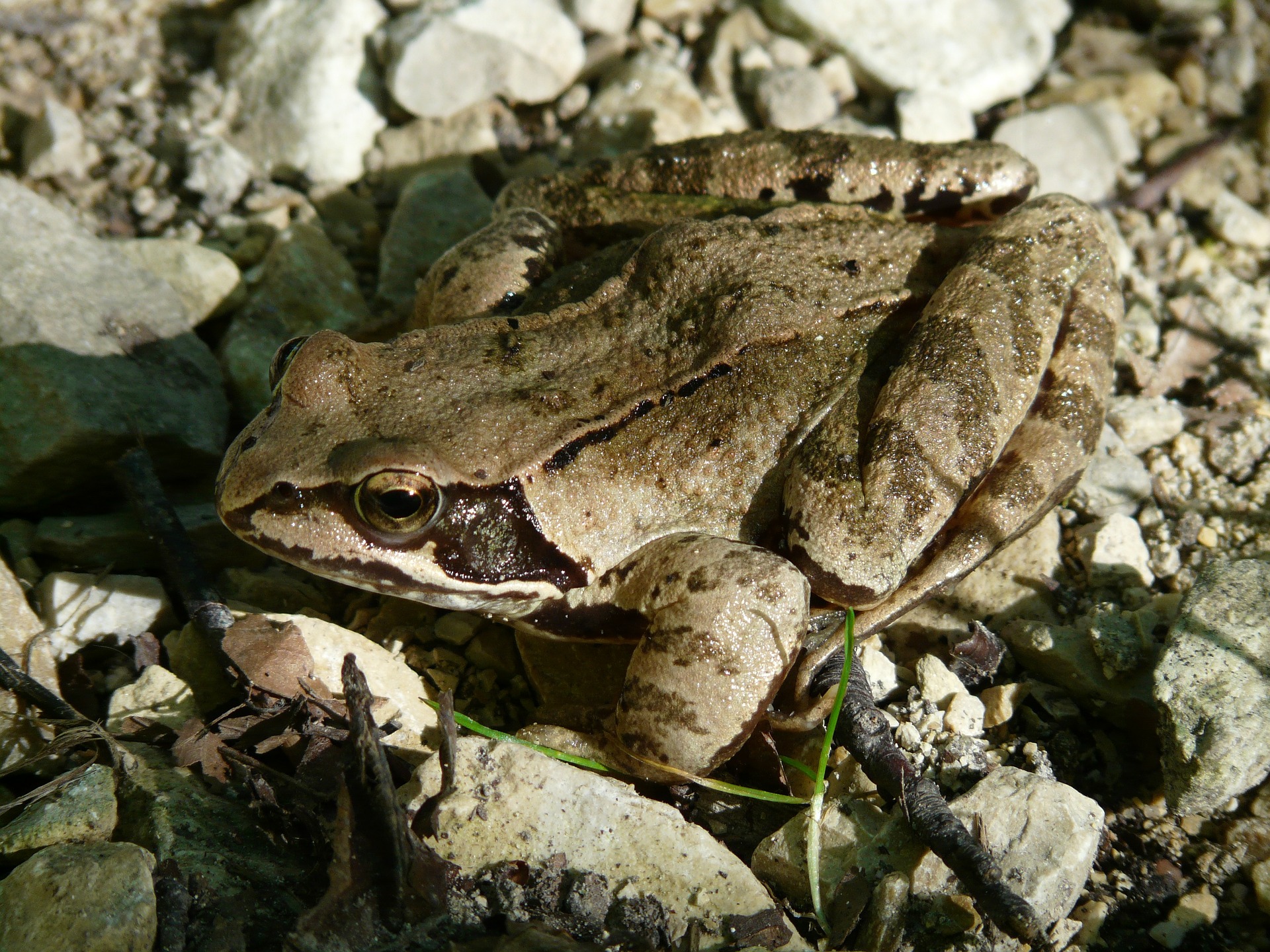
Having the unique ability to lighten or darken their skin to camouflage themselves against their surroundings allows them to forage and hide from predators throughout the spring and summer. Adapting to hide from predators, they have the ability to sit just below the water for long periods of time as their eyes and nostrils are positioned on the top of their head, allowing them to get oxygen.
Being cold blooded, the common frog cannot function in low temperatures and chooses to hibernate through the winter. Interestingly, they can breathe through their skin so can hibernate underwater at the bottom of ponds for several months.
Common Toad
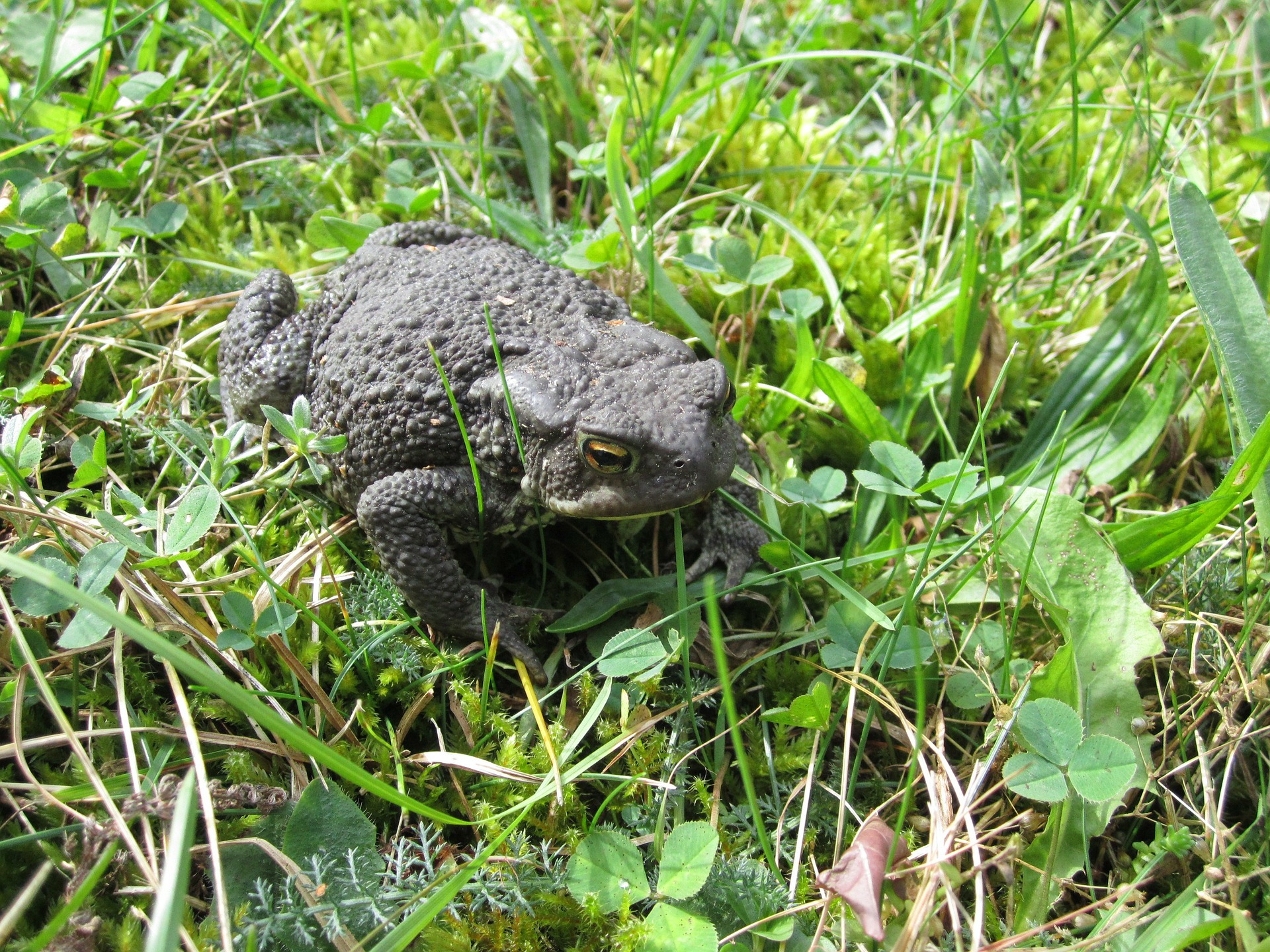
These amphibians can be distinguished by their dry, warty skin with coppery eyes and short legs. On the move, this species walks rather than hops like other amphibians and has the ability to secret a vile-tasting substance from its warts to warn off predators.
An interesting part of the common toad’s life cycle is when they mass migrate back to breeding ponds on the first warm damp evenings of the year, often in February.
After breeding in ponds, laying their eggs in strings along aquatic plants, they spend the rest of the year feeding in woodlands and grasslands.
Most commonly choosing a diet of snails, slugs and insects, the common toad can grow up to 13cm long and even prey on mice, slow worms, small grass snakes and smaller toads.
During winter these toads can hibernate like frogs under logs and stones. However, they often choose to overwinter rather than hibernate. This entails the species spending most of its time hidden and conserving energy but emerging to forage for food in milder weather.
Found throughout the majority of mainland Britain, common toads spend most of the year in damp, shaded areas, such as woodland habitats and can often be seen in gardens from February to October.
In the UK, Common Toads are:
- Protected in the UK under the Wildlife and Countryside Act, 1981.
- A Priority Species under the UK post-2010 biodiversity framework.
Smooth Newt
Also known as common newts, these amphibians are widespread throughout the UK, often found in gardens and ponds.
Best to see from March to October, these newts emerge from hibernation in spring, breeding in water in summer and laying up to 300 eggs on broadleaved plants. They then spend the rest of the year, up to hibernation in October, in grassland and woodland.
Distinguished by their olive colour, orange belly and black spots, male smooth newts develop a smooth crest along the length of their body and tail during breeding season.
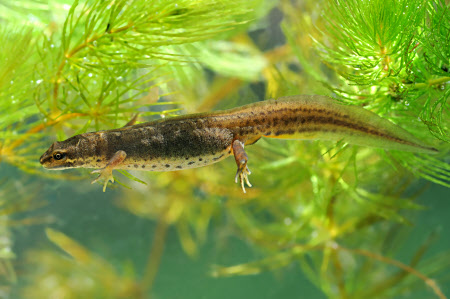
Interestingly, these amphibians have a varied diet depending if they are on land or in water. On land, they eat caterpillars, worms and slugs, while in the water they hunt crustaceans, molluscs and tadpoles.
Protected in the UK, Smooth Newts are:
- A Protected Species in the UK under the Wildlife and Countryside Act, 1981
Great Crested Newt
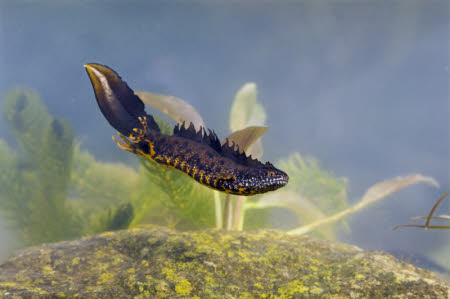
Named for the prominent wavy crest that males develop during breeding season, these interesting animals are the largest and rarest newt species in the UK.
Throughout the year they can be easily distinguished from smooth newts by their warty appearance, made by small bumps along the skin. Interestingly, these black newts can be identified from each other by the unique pattern of black spots along their bright yellow or orange bellies.
The great crested newt spends most of its life on land in habitats like woodlands and marshes that contain hedgerows and boggy grassland which lets them hunt invertebrates and provides refuge in winter. Although they are able to hide easily among vegetation to avoid predators, they also have a great ability to secret an acrid-smelling substance as a secondary defence mechanism.
The only part of the year these amphibians do not spend on land is during breeding season, from April to May, where they mate and lay eggs in ponds. Did you know female newts lay from 200-300 eggs, wrapping each one on separate pond plant leaves?
The pond great crested newts chose is very significant as they only chose high quality water bodies, so much so that they can travel up to 1km to find the best pond!
After around 21 days, about half the eggs originally laid will have survived and emerged as tadpoles. They initially feed on small insects until they mature and can move onto land, eating worms, slugs and insects and tadpoles and molluscs when they venture into the water. Having a varied diet is important for these nocturnal newts as they are voracious eaters (needing high quantities of food) and must stay close to waterbodies to keep their skin moist.
Best seen from March to October, great crested newts hibernate underground from October, among tree roots, in muddy banks or in compost heaps to shelter during the colder months. When temperatures start to rise, they return to the ponds they were born to breed.
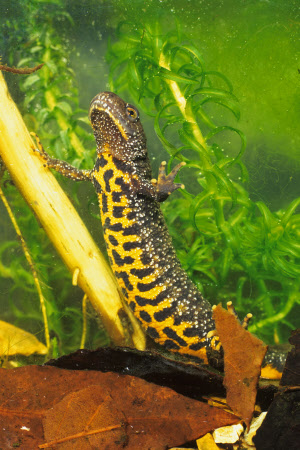
The population of great crested newts is important in the UK as their populations are declining through Europe due to habitat loss. As such, them and their habitats are protected under European Law.
Under these laws, Great Crested Newts are:
- Protected in the UK under the Wildlife and Countryside Act, 1981
- A Priority Species under the UK Post-2010 Biodiversity Framework
- Listed as a European Protected Species under Annex IV of the European Habitats Directive.
Although these species are protected, they have seen a drastic decline over the last 60 years, losing roughly 50% of ponds in the UK alone. As a result, Natural England have started to implement a scheme to combat their decline. This ‘District Level Licensing’ scheme focuses on managing great crested newts and their habitats on the wider landscape scale, rather than on a site-by-site basis. Which would often result in pond habitats becoming poor and disconnected. By using this scheme, developers can avoid specific areas and beneficial habitats can be created for great crested throughout the landscape. Benefitting developers as well, this scheme allows them to avoid costly delays. To read more about this interesting approach visit https://www.gov.uk/government/news/innovative-scheme-to-conserve-newts-and-promote-sustainable-development-is-rolled-out-across-england






